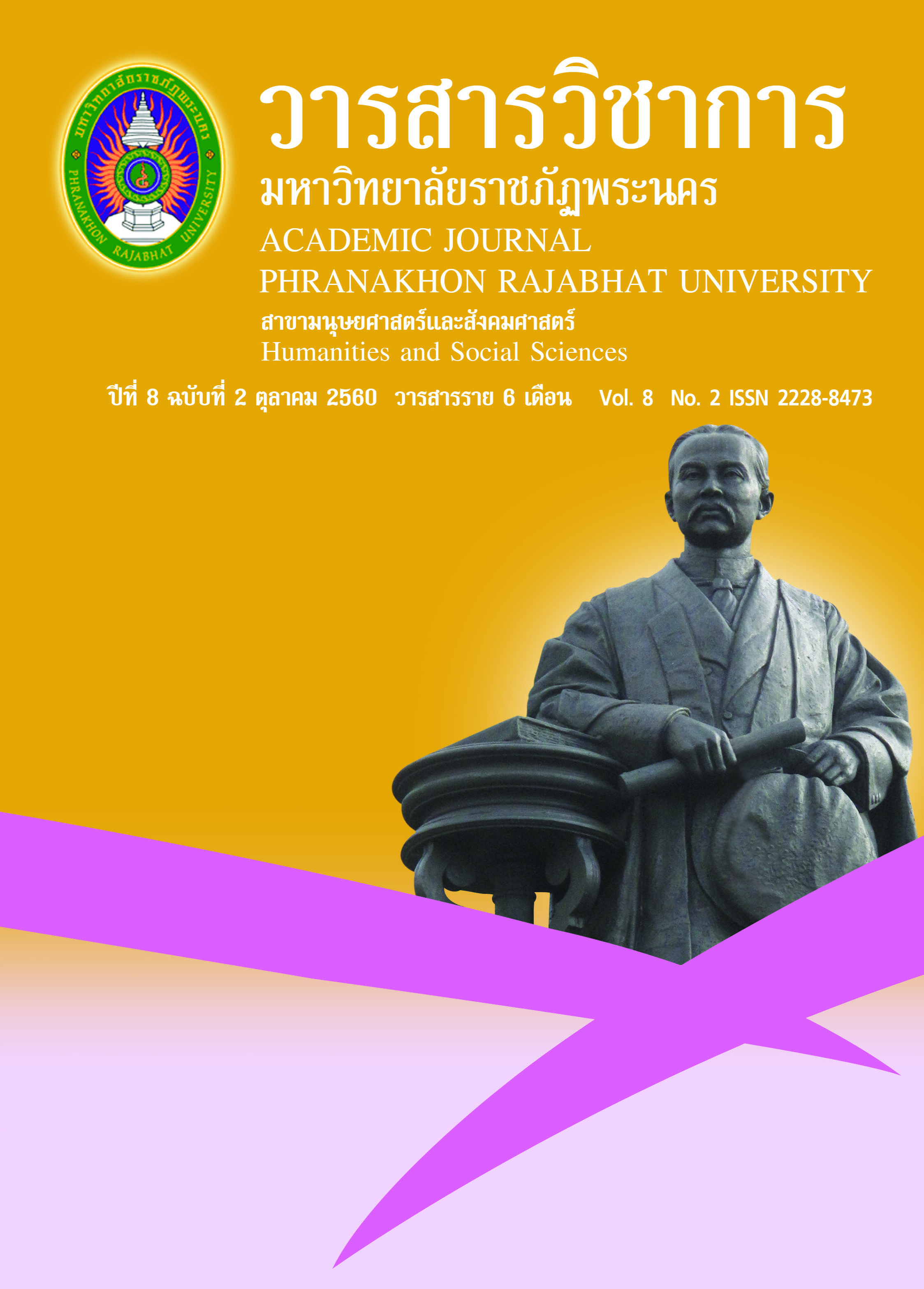กลยุทธ์การสื่อสารการตลาดแบบบูรณาการที่มีอิทธิพลต่อพฤติกรรมการตัดสินใจเข้าศึกษาต่อของนักศึกษาที่มหาวิทยาลัยราชภัฏในประเทศไทย
Keywords:
ลยุทธ์, การสื่อสารการตลาด, แบบบูรณาการงบประมาณ, มหาวิทยาลัยราชภัฏAbstract
การวิจัยครั้งนี้มีวัตถุประสงค์ (1) เพื่อศึกษาอิทธิพลของปัจจัยเหตุที่มีผลต่อกลยุทธ์การสื่อสารการตลาดแบบบูรณาการของมหาวิทยาลัยราชภัฏในประเทศไทย (2) เพื่อศึกษาอิทธิพลของกลยุทธ์การสื่อสารการตลาดแบบบูรณาการที่มีต่อพฤติกรรมการตัดสินใจเข้าศึกษาต่อของนักศึกษาที่มหาวิทยาลัยราชภัฏในประเทศไทย โดยผู้วิจัยเลือกใช้รูปแบบการวิจัยแบบผสมผสาน คือ การดำเนินการวิจัยเชิงคุณภาพ ร่วมกับการดำเนินการวิจัยเชิงปริมาณ โดยผู้ให้ข้อมูลหลักเป็นผู้ที่บริหารที่มีส่วนร่วมในวางแผนหรือเป็นผู้รับผิดชอบในการกำหนดกลยุทธ์การสื่อสารการตลาดแบบบูรณาการของมหาวิทยาลัยราชภัฏในกลุ่มรัตนโกสินทร์จำนวน 5 ท่าน เครื่องมือที่ใช้ในการวิจัยคือ แบบสัมภาษณ์กลยุทธ์การสื่อสารการตลาดแบบบูรณาการที่มีอิทธิพลต่อพฤติกรรมการตัดสินใจเข้าศึกษาต่อของนักศึกษาที่มหาวิทยาลัยราชภัฏในประเทศไทย วิเคราะห์ข้อมูลโดยการวิเคราะห์เนื้อหา และการศึกษาเชิงปริมาณ ประชากรคือ นักศึกษา ของมหาวิทยาลัยราชภัฏในกลุ่มรัตนโกสินทร์ โดยมีขนาดของกลุ่มตัวอย่างจำนวน 400 คน โดยใช้วิธีการสุ่มตัวอย่างแบบหลายขั้นตอน เครื่องมือที่ใช้คือแบบสอบถาม วิเคราะห์ข้อมูลโดยการวิเคราะห์ค่าสัมประสิทธิ์สหสัมพันธ์แบบเพียร์สัน และวิเคราะห์โมเดลสมการโครงสร้างความสัมพันธ์ปัจจัยเหตุและผลของกลยุทธ์การสื่อสารการตลาดแบบบูรณาการของมหาวิทยาลัยราชภัฏ ผลการวิจัยพบว่า ปัจจัยเหตุ งบประมาณ การวางตำแหน่งแบรนด์และ พันธกิจของมหาวิทยาลัยราชภัฏ มีอิทธิพลทางตรงเชิงบวกต่อกลยุทธ์การสื่อสารการตลาดแบบบูรณาการ เท่ากับ 0.53 ,0.20 และ 0.20 ตามลำดับ อย่างมีนัยสำคัญทางสถิติที่ระดับ .01 และพบอีกว่ากลยุทธ์การสื่อสารการตลาดแบบบูรณาการ มีอิทธิพลทางตรงเชิงบวกต่อพฤติกรรมการตัดสินใจเข้าศึกษาต่อของนักศึกษา อย่างมีนัยสำคัญทางสถิติที่ระดับ .01 โดยที่พฤติกรรมการตัดสินใจเข้าศึกษาต่อของนักศึกษา ได้รับอิทธิพลรวมจากกลยุทธ์การสื่อสารการตลาดแบบบูรณาการ เท่ากับ 1.90 นอกจากนี้ พฤติกรรมการตัดสินใจเข้าศึกษาต่อของนักศึกษา ได้รับอิทธิพลทางอ้อมจากงบประมาณ การวางตำแหน่งแบรนด์ และพันธกิจของมหาวิทยาลัยราชภัฏ เท่ากับ 1.00, 0.37 และ 0.39 ตามลำดับ ซึ่งเป็นค่าอิทธิพลที่มีนัยสำคัญทางสถิติที่ระดับ .01
References
สำนักงานคณะกรรมการการอุดมศึกษา. (2554). แผนการกํากับดูแลองค์การทีดีของสํานักงาน คณะกรรมการการอุดมศึกษา.
Ann Gibson.(2009). "Budgeting in higher education."
Armstrong & Lumsden, (1999). Natural learning in higher education. In Encyclopedia of the Sciences of Learning (pp. 2426-2433). Springer US
Berry, R. S. (1999). Dynamics on statistical samples of potential energy surfaces. The Journal of chemical physics, 111(5), 2060-2070.
Creswell, (2009). Qualitative procedures. Research design: Qualitative, quantitative, and mixed methods approaches, 173-202.
Dyer, W. G., & Whetten, D. A. (2006). Family firms and social responsibility: Preliminary evidence from the S&P 500. Entrepreneurship Theory and Practice, 30(6), 785-802.
Dawes &Brown, (2002). Determinants of awareness, consideration, and choice set size in university choice. Journal of Marketing for Higher Education, 12(1), 49-75.
David Wayne Horrigan. (2007). Integrated marketing communications in higher education.
Fowler Jr, F. J. (2013). Survey research methods. Sage publications.
Hair, J.F., Anderson, R.E., Tatham, R.L., & Black, W.C. (1998). Conjoint analysis. Multivariate data analysis.
Jacqueline N. Gustafson. (2010). Faith-Based Institutions, Institutional Mission, and the Public Good
Kotler, P. (2003), “Marketing Management”, 11ed, Prentice Hall, New Jersey, USA
Katherine Culliver,(2016). Integrated Marketing and Nontraditional Student Enrollment Decision Making (Doctoral dissertation, UNIVERSITY OF LA VERNE
Klassen, (2000). Learning to read words: Linguistic units and instructional strategies. Reading research quarterly, 35(4), 458-492.
Kitchen, J. (2005). Looking backward, moving forward: Understanding my narrative as a teacher educator. Studying Teacher Education, 1(1), 17-30.
Licata, J., & Frankwick, G. L. (1996). University marketing: a professional service organization perspective. Journal of Marketing for Higher Education, 7(2), 1-16.
Mary Kathleen Leonard Getty (1998) Supplemental Selected Bibliography on Multicultural Education. Transformations: The Journal of Inclusive Scholarship and Pedagogy, 9(2), 258-285.
Mount, J., & Belanger, C. H. (2004). Entrepreneurship and image management in higher education: Pillars of massification. Canadian Journal of Higher Education, 34(2), 125-140.
McCormack, M. (2005). The Independent Man: Citizenship and Gender Politics in Georgian England. Manchester University Press
M’Gonigle and Starke, (2006). Student engagement in place making at an Australian university campus. Australian Planner. p. 36
Paul Trapp.(2010) University brand equity: an empirical investigation of its dimensions. International Journal of Educational Management, 28(6), 616-634.
Rosen, D. E., Curran, J. M., & Greenlee, T. B. (1998). College choice in a brand elimination framework: the administrator's perspective. Journal of Marketing for Higher Education, 8(4), 61-81.
Rabiee, F. (2004). Focus-group interview and data analysis. Proceedings of the nutrition society, 63(04), 655-660.
Sands, J. S., & Smith, M. O. (1999). Broilers in heat stress conditions: effects of dietary manganese proteinate or chromium picolinate supplementation. The Journal of Applied poultry research, 8(3), 280-287.
Shimp,(2010) Advertising, Promotion, and Other Aspects of Integrated Marketing Communications, 8th edition
Spellings, M. (2006). A test of leadership: Charting the future of US higher education. US Department of Education.
Tamilla Curtis. (2009). Corporate brand management in higher education: the case of ERAU. Journal of Product & Brand Management, 18(6), 404-413.
Yamane, T. (1973). Statistics: an introductory analysis-3.
Downloads
Published
How to Cite
Issue
Section
License
"บทความวิชาการในวารสารฉบับนี้ ถือเป็นความรับผิดชอบของผู้เขียนเท่านั้น"
สงวนลิขสิทธิ์ตามพระราชบัญญัติลิขสิทธิ์




